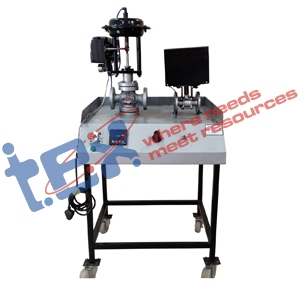

The Final Control Element Pneumatic and Electrical Operated Trainer is a specialized process control educational setup designed to study the operation, calibration, and response of final control elements such as electrical and pneumatic control valves. This advanced training equipment enables students to understand how control signals regulate flow, pressure, and level in various industrial automation systems.
Ideal for Engineering Colleges, ITIs, and Technical Training Centers, this final control element trainer bridges the gap between theoretical learning and industrial applications. It demonstrates the real-world performance of both electrically operated and pneumatically actuated control valves, allowing learners to visualize the role of the final control element in process loops.
The Final Control Element Pneumatic and Electrical Operated Trainer is built with two integrated systems — one for pneumatic control valves and another for electrical actuators. The unit demonstrates how control signals (4–20 mA or 0–5 V DC) operate the valve to adjust flow rates or process variables.
The pneumatic control valve section includes an air supply, I/P converter (current-to-pressure), positioner, and feedback mechanism, while the electrical section includes a motorized control valve with limit switches and position feedback indicators. Together, they help users study valve dynamics, response characteristics, hysteresis, and calibration.
Constructed with industrial-grade components, the trainer features a powder-coated steel panel, clear instrumentation layout, and safety protection circuits. It serves as a reliable lab system for long-term academic and industrial training use.
| Specification | Details |
|---|---|
| Power Supply | 230V AC, 50Hz |
| Electrical Control Valve Type | Motorized valve with position feedback and limit switches |
| Pneumatic Control Valve Type | Air-operated globe valve with I/P converter and positioner |
| Input Signal | 4–20 mA DC or 0–5 V DC |
| Pressure Source | Regulated air supply with pressure gauge and flow control |
| Display Instruments | Digital indication for valve position, current, and voltage |
| Frame Construction | MS powder-coated panel with mounted components |
| Safety Features | Overload, short-circuit, and pressure relief protection |
| Optional Add-ons | Interface with PLC or DCS controller |
This Final Control Element Trainer provides a complete understanding of how control valves respond to input signals and regulate process parameters. Students gain valuable practical experience in pneumatic and electrical actuator operation, feedback mechanisms, and process loop dynamics.
By performing experiments on both valve types, learners can compare response times, control accuracy, and performance under varying load conditions. The setup helps them develop essential skills required in industrial process control, automation, and instrumentation engineering.
Suitable for Engineering Colleges, ITIs, Polytechnics, and Research Labs, this trainer aligns perfectly with modern industrial standards, helping institutions enhance the quality of hands-on instrumentation education.